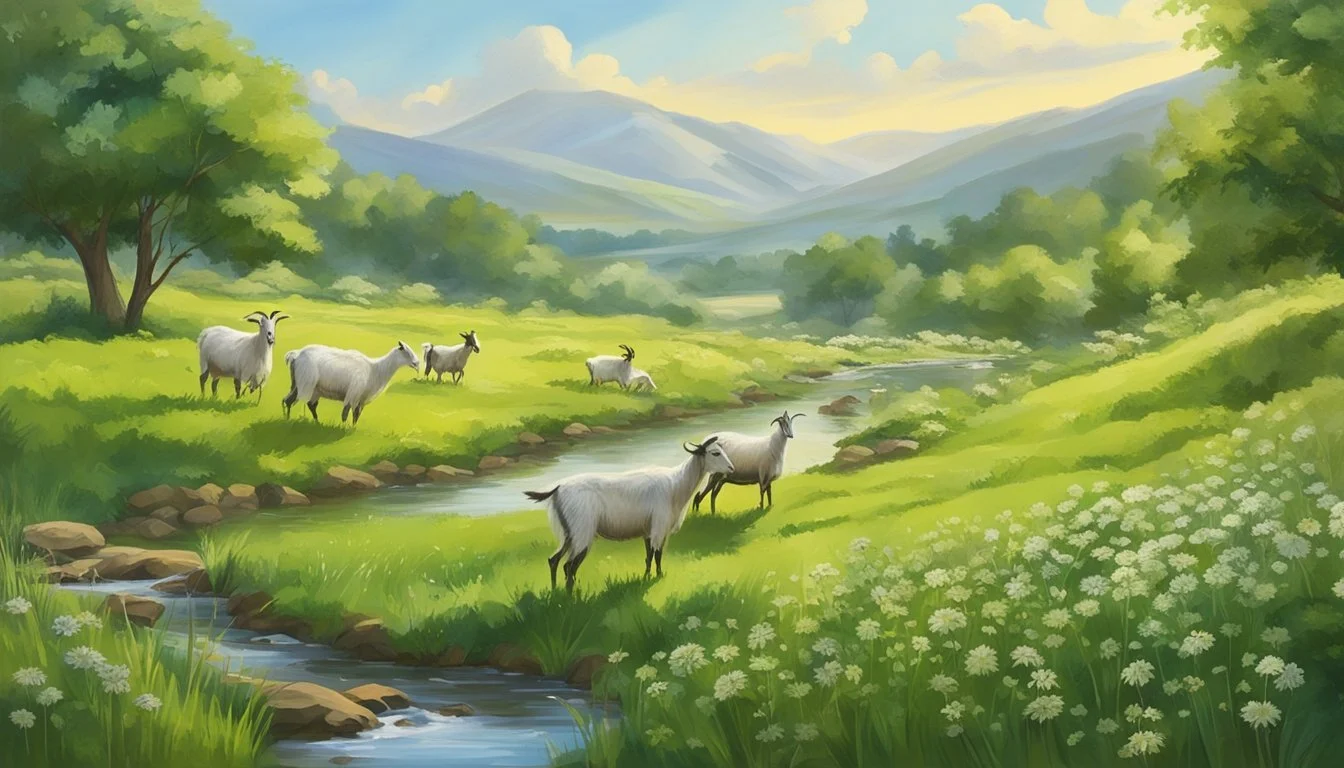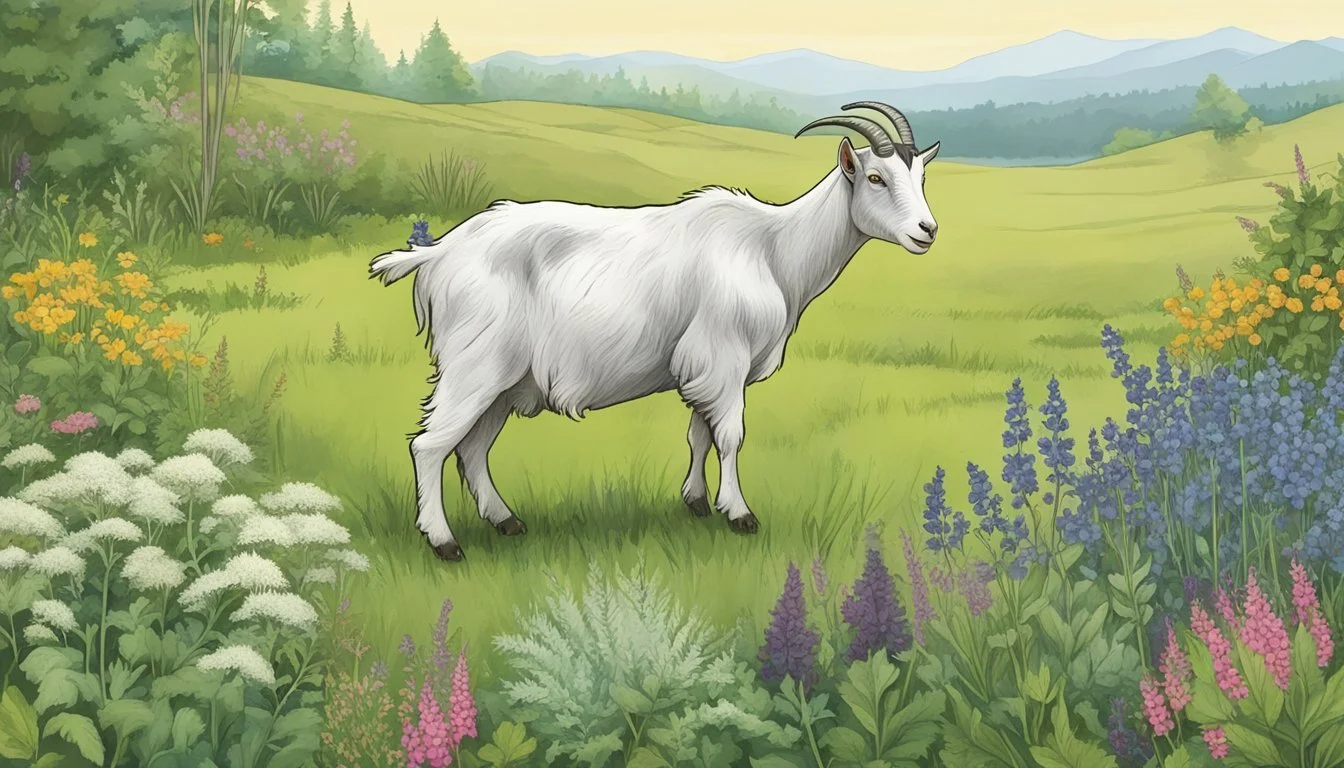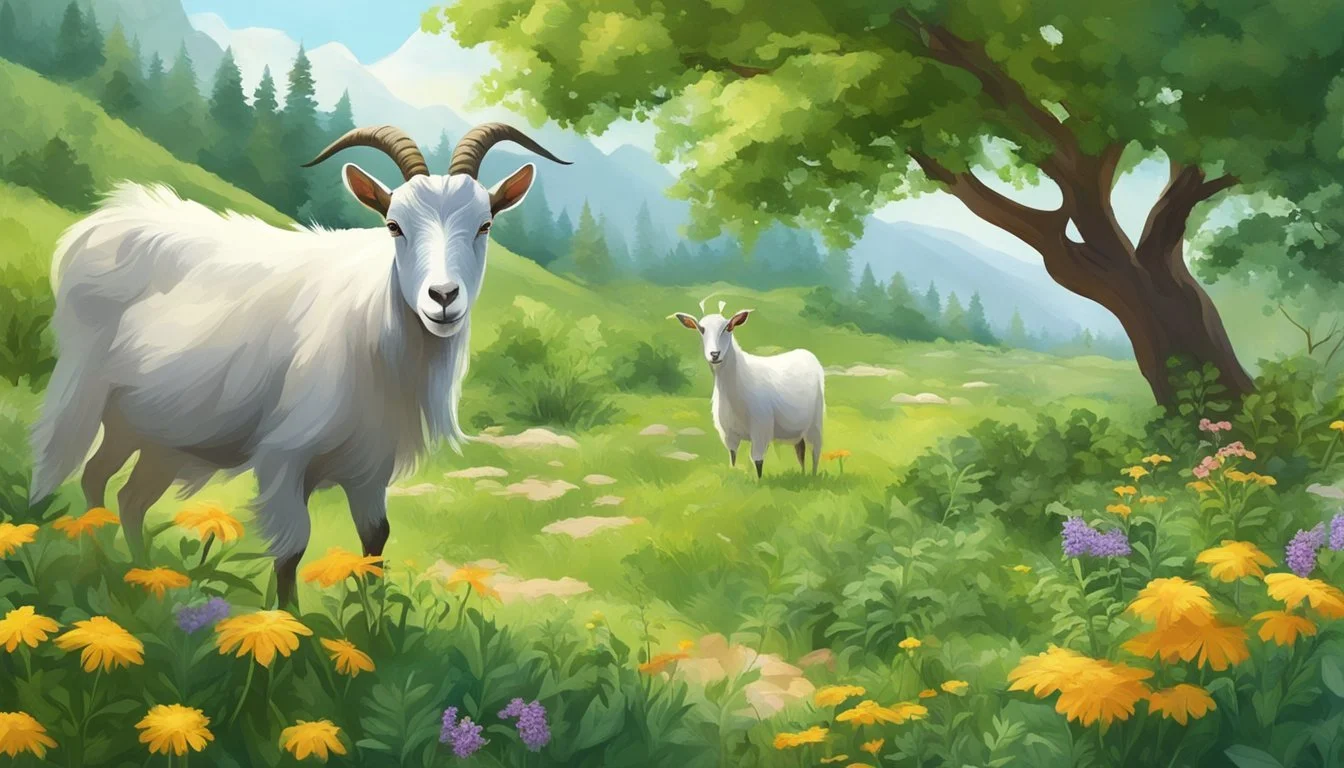Companion Planting for Your Goat Pasture
Optimize Grazing with These Beneficial Herbs and Plants
Companion planting is a strategic approach to gardening and agriculture where various plants are grown together for mutual benefit. When it comes to creating a goat pasture, incorporating specific herbs and plants can lead to a healthier and more productive environment. These botanical companions can provide a range of advantages, from improving soil quality to offering natural pest control and enhancing animal health.
Selecting the right combination of foliage can not only bolster the nutritional value of the forage available to the goats but can also help manage pasture integrity and sustainability. For instance, planting herbs like lavender can help repel harmful insects while attracting beneficial pollinators. Moreover, certain legumes, such as sericea lespedeza, contribute to the pasture's health by offering high-quality forage and aiding soil fertility through nitrogen fixation.
Incorporating plants like forage chicory into pastures can significantly improve livestock nutrition due to its high digestibility and protein content. This concept delivers a clear message: a well-planned goat pasture, rich in diverse plant species, not only benefits the land and the animals but is also a testament to the symbiotic relationship between agriculture and the natural ecosystem.
The Basics of Companion Planting
In the realm of agriculture, companion planting stands as a strategic approach that can enhance growth, health, and yields. This method involves the careful pairing of different plants with complementary characteristics.
Understanding Companion Planting
Companion planting is the agricultural practice of cultivating specific plants in proximity to one another due to their ability to offer mutual benefits. This technique can influence the health and growth of plants within a goat pasture by utilizing the natural relationships between different herbs and flora. For instance, certain herbs might deter pests that would otherwise be detrimental to neighboring plants, or they could even improve soil nutrients.
Benefits of Companion Planting
Through companion planting, benefits extend beyond pest management; this approach also contributes to enhanced growth and potentially higher yields. One plant species might attract beneficial insects that act as pollinators for another, or they might provide necessary shade that reduces the stress on more heat-sensitive plants. Optimizing the spatial arrangement and species combinations in a goat pasture can improve the overall health of the pasture ecosystem.
Planning Your Goat Pasture
Creating an optimal goat pasture requires careful planning, with special attention to the available space, sunlight exposure, soil characteristics, and strategic incorporation of companion plants to maintain a healthy and productive environment.
Assessing Space and Sunlight
When mapping out a goat pasture, one must consider the space each animal needs to graze comfortably—typically between 200 to 500 square feet per goat. This area should receive sufficient sunlight, as shade from buildings or trees can significantly impact the growth of forage crops and companion plants. An ideal pasture has areas with both sun and shade to meet the preferences of goats throughout the day.
Analyzing Soil pH and Composition
The next critical step involves analyzing soil pH and composition. Goats prefer forage from soils with a pH between 6.0 and 7.0, which allows for optimal nutrient availability. One should conduct a soil test to determine the pH level and adjust accordingly using lime to increase pH or sulfur to decrease it. The soil’s texture and nutrient content are also vital; loamy soil rich in organic matter tends to support a diverse range of plant species.
Incorporating Companion Plants Strategically
Incorporating companion plants into a goat pasture not only enhances the pasture's ecological balance but also boosts the goats' health. Certain herbs can serve as natural dewormers, such as chicory, while others like bird's foot trefoil can fix nitrogen in the soil, improving fertility. It is recommended to arrange companion plants in a manner that increases biodiversity, reduces pest incidence, and provides various nutritional benefits to the goats.
By adhering to these guidelines, one establishes a sound foundation for a thriving goat pasture.
Selecting Companion Herbs and Plants
Choosing the right companion plants and herbs for a goat pasture can have a multitude of benefits, including enhancing the ecosystem, attracting beneficial insects, and promoting goat health.
Herbs That Boost Pasture Ecosystem
Integrating a variety of herbs into a goat pasture can improve soil quality and create a more resilient ecosystem. Herbs such as chives, fennel, and lovage provide dense foliage that can help suppress weeds, while their strong scents may deter pests. Dill and tarragon can also serve to enhance the flavor of other plants in the pasture.
Chamomile: enriches the soil with calcium, potassium, and sulfur
Borage: known for its ability to add trace minerals to the soil
Attracting Beneficial Insects with Plants
To maintain a healthy pasture and control pest populations, attracting beneficial insects is key. Plants like mint, basil, and sage are excellent at luring pollinators like bees and butterflies which are vital for plant health.
Lavender: repels fleas and moths while attracting pollinators
Rosemary: deters bean beetle and cabbage moth
For controlling aphids and Japanese beetles, marjoram and tarragon work to attract ladybugs and parasitic wasps that prey on these pests.
Plants for Optimal Goat Health
Certain plants provide direct health benefits to goats when incorporated into their diet. Fennel and dill are known digestive aids, while oregano has natural antibiotic properties.
Parsley: high in vitamins and boosts goat immunity
Thyme: aids in respiratory health
Combining these plants not only benefits the goats but can also lead to the overall enhancement of the pasture's health and productivity.
Companion Planting Chart for Goats
Companion planting in goat pastures can not only enhance the nutritional value of forage but also support pest management and soil health. This section offers a detailed chart and examples of specific plant combinations that are beneficial for a goat-optimized pasture.
Sectional Companion Planting Guide
A companion planting chart serves as a reference to pair plants that can mutually benefit each other when grown in proximity. The chart below categorizes different plants that are compatible with each other in a goat pasture.
Companion Plant: Legumes (e.g., Beans, Peas)
Benefits: Fix nitrogen in soil, improving fertility.
Compatible With: Corn, Squash
Companion Plant: Grasses (e.g., Corn)
Benefits: Act as trellises for climbing plants.
Compatible With: Beans, Cucumbers
Companion Plant: Brassicas (e.g., Cabbage, Kale, Brussels Sprouts)
Benefits: Attract beneficial insects.
Compatible With: Aromatic herbs (e.g., Dill, Mint)
Companion Plant: Alliums (e.g., Onions, Garlic)
Benefits: Act as pest deterrents.
Compatible With: Brassicas, Tomatoes
Companion Plant: Umbellifers (e.g., Carrots, Celery)
Benefits: Provide ground cover and attract predator insects.
Compatible With: Lettuce, Spinach
Companion Plant: Cucurbits (e.g., Squash, Cucumbers)
Benefits: Provide shade which helps to retain soil moisture.
Compatible With: Corn, Radish
Specific Plant Combinations
To optimize the benefits of companion planting for goats, it is important to consider specific combinations that contribute to a healthy and productive pasture. Some of these combinations include the following:
Tomatoes and Basil - Planting basil around tomatoes can help to repel harmful insects and enhance the flavor of the tomatoes.
Cabbage and Marigolds - Marigolds are known to deter cabbage worms and other pests, protecting cabbage plants.
Corn and Squash - Squash acts as a living mulch, preventing weeds and retaining soil moisture for the corn while the corn stalks provide a structure for squash vines to grow.
Carrots and Onions - The strong scent of onions can deter carrot fly, protecting the carrot crop.
Implementing these companion planting strategies in a goat pasture can result in a diverse and sustainable environment that establishes a holistic and balanced ecosystem to benefit both the livestock and the land.
Managing Pests and Disease
When integrating companion planting into goat pastures, the focus is often on curbing the prevalence of pests and diseases which can impact plant health and the wellbeing of livestock. Strategic use of specific plants can lead to a natural and sustainable way to maintain healthy pasture ecosystems.
Natural Pest Control with Companion Planting
In the context of goat pasture management, certain plants offer the dual benefit of enhancing pasture quality and repelling unwanted pests. For example, the cultivation of herbs like garlic and chives can act as a deterrent to aphids and Japanese beetles. Incorporating fragrant species such as basil effectively drives away harmful insects and can minimize the risk of pest invasions that could cause significant damage to the pasture's flora.
Common pests addressed through companion planting:
Aphidsng unwan
Japanese beetles
Flea beetles
Flies
Utilizing these plants strategically can limit the needs for chemical pesticides, which aligns with a holistic and organic approach to pasture management.
Reducing Diseases in Pasture through Plant Diversity
Introducing a variety of plants to a goat pasture is not only beneficial for soil health and fodder but also helps to reduce plant diseases. A diverse plant ecosystem creates challenges for disease organisms that thrive on specific host plants. For instance, intercropping strong-scented herbs can mask the scent of nearby crops, decreasing the likelihood of disease transmission by pests like the cabbage moth.
Examples of diseases and pests managed through plant diversity:
Spider mites
Moth larvae (e.g., tomato hornworm, cabbage moth)
Overall, plant diversity can be an effective approach to creating a resilient goat pasture that supports animal health and reduces disease pressure on vegetation.
Maximizing Harvest and Quality
When integrating companion planting into a goat pasture, the focus lies in selecting herbs and plants that can enhance both the nutritional value and the palatability of forage, leading to improved health and productivity of the herd. It involves a strategic approach that can benefit the ecosystem of the pasture and contribute to sustainable farming practices.
Enhancing Flavors and Aromatics
Herbs like mint and lemon balm not only introduce a pleasant smell to the pasture but can also influence the flavor of goat milk. Planting these alongside forage crops can make the pasture more appealing to the goats, ensuring they consume a diverse diet. This diversity can be directly linked to the flavor profile of the goat milk and meat, which is enhanced by the different aromatic compounds present in the companion plants.
Mint: Adds a fresh aroma to the pasture, potentially improving the scent and taste of goat milk.
Lemon Balm: Known for its citrus scent, it may enhance the subtleties in milk flavor.
Improving Plant Growth and Yields
Companion planting can lead to better plant growth and higher forage yields by leveraging the natural relationships between certain plants. For instance, legumes like clover fix nitrogen in the soil, enriching it for the surrounding grasses and increasing their nutritional value. This interaction not only supports the improved growth of pasture plants but also leads to higher yields of quality forage.
Clover: It's a nitrogen fixer that benefits grasses by improving soil fertility, which can enhance growth and yield.
Chicory: This deep-rooted plant can break up compacted soil, allowing for better root development and nutrient uptake of companion plants.
Implementing companion planting strategies with herbs and beneficial plants can significantly contribute to a robust forage system for goats, directly impacting the harvest's quality and quantity.
Auxiliary Plants for Overall Benefits
Incorporating specific flowers and herbs alongside pastures not only boosts the aesthetic appeal but also promotes a healthier environment for goats. These plants can offer a range of benefits from enhancing flavor to providing functional advantages such as pest repellence.
Companion Flowers for Aesthetic and Functional Advantage
Companion flowers serve a dual purpose in goat pastures. They add visual appeal while also contributing to the health and well-being of the goats. Flowers such as roses are not just aesthetically pleasing; they can also offer a calming environment for the pasture's inhabitants. It is, however, important to ensure that any flowers within reach of the goats are non-toxic and beneficial to their diet.
Cultivating Catnip, Marigolds, and Nasturtiums
Catnip: Often associated with cats, catnip is also beneficial for goats. It can help deter insects and is safe for goats to consume in moderation, providing a comforting effect.
Marigolds: Introducing marigolds can serve multiple purposes. Not only do they brighten up the pasture with their vibrant colors, but their strong scent is known to repel pests and can improve the overall flavor of the goats' milk.
Nasturtiums: These plants are another excellent choice for a companion plant. They provide an aesthetic boost with their bright and large flowers while offering benefits such as promoting the health of the goats and potentially improving the flavor of their forage.
Creating a Sustainable Goat Pasture Ecosystem
Creating a sustainable ecosystem within a goat pasture involves strategic planning and planting. Integrating methods such as the Three Sisters, alongside cultivating beneficial plant relationships, can result in a thriving vegetable garden that supports the broader pasture ecosystem.
Employing the Three Sisters Method
The Three Sisters method employs a trio of mutually beneficial crops — corn, beans, and squash — which can be a part of a sustainable garden within a goat pasture. Corn provides a natural structure for beans to climb, eliminating the need for artificial stakes. Beans, in turn, fix nitrogen in the soil, enriching it for other plants. Squash, with its broad leaves, shades the ground, keeping weeds at bay and preserving soil moisture. These interplanting tactics result in a synergistic relationship where each vegetable supports the others, creating a balanced ecosystem.
Building Relationships with Plant Friends
Cultivating plant friends involves integrating herbs and other companion plants that offer various benefits. Certain herbs, like lavender and rosemary, can act as natural pest deterrents, thereby reducing the reliance on chemical treatments. Companion planting can also encourage pollinators, enhance soil quality, and improve the overall health of the goat pasture. For example:
Legumes: These plants are friends to many in the garden by improving soil fertility.
Marigolds: Known to deter pests while adding a pop of color.
Through thoughtful companion planting, they can contribute to a sustainable ecosystem where goats and garden plants support one another.
Practical Tips for Implementation
Implementing companion planting in a goat pasture requires thoughtful planning and ongoing attention to detail. This section outlines specific steps to help integrate beneficial herbs and plants into the pasture effectively.
Seasonal Considerations for Planting
Spring: Ideal for sowing frost-tolerant herbs such as parsley or mint, which can provide ground cover and beneficial insects to the area.
Summer: Plant heat-loving plants like basil to deter pests naturally and provide shade for smaller plants.
Autumn: A perfect time to plant perennials like comfrey, as it is robust and can provide soil enrichment throughout the winter.
Carefully timing your planting helps ensure that the companion plants establish themselves and become beneficial components of the pasture ecosystem.
Maintenance and Care for Companion Plantings
Regular Inspection:
It’s imperative to regularly inspect the companion plants for signs of disease or pest infestation.
Remove any weeds that might compete with the companion plants for nutrients.
Watering and Fertilization:
While goats will naturally fertilize the area, additional compost or organic matter might be needed for optimal plant health.
Ensure companion plants receive adequate water, especially during dry spells.
By attending to these maintenance and care practices, one ensures the longevity and vitality of the companion planting system within the goat pasture.
Companion Planting in Culinary Use
In the context of a goat pasture, certain herbs and plants offer not only health benefits for the livestock but also provide a bounty of flavors and aromas for culinary use. The concept of companion planting encompasses both the growth and the eventual harvest of plants that serve a dual purpose in management of pasture health and enhancement of human diets.
From Pasture to Plate: Selecting Edibles
When it comes to integrating edibles into a goat pasture, it's essential to choose plants that are both beneficial to the goats and useful in the kitchen. Robust herbs such as rosemary, sage, and oregano not only withstand grazing but also add depth to a variety of dishes. Lightweight and fragrant herbs like cilantro and dill are better protected in dedicated sections of the pasture to prevent overgrazing and to ensure they can be harvested for their culinary uses.
Cilantro: A versatile herb used in salsas and as a garnish for many dishes.
Basil: Perfect for pesto and pairs well with tomato-based dishes.
Dill: Sought after for pickling and for flavoring fish and soups.
Erecting small barriers or planting these in raised beds within the pasture can protect delicate herbs while still reaping the agronomic benefits of companion planting.
Herbs and Plants in Dishes and Teas
The delicate balance of flavor is crucial in the creation of both dishes and teas. Companion planted herbs like parsley and fennel can be snipped fresh to enliven dishes with their vibrant, aromatic qualities. For teas, flowers such as chamomile and lavender are not only therapeutic for goats but also create soothing, flavorsome infusions.
Sage: Its earthy and peppery flavor is a staple in poultry seasoning and sausages.
Mint: Refreshing in both sweet and savory dishes, also a classic for herbal teas.
Tarragon: Known for its anise-like flavor, it elevates chicken and egg dishes.
Furthermore, the inclusion of rosemary in meat marinades or oregano sprinkled over pizza provides a culinary bridge from the natural goodness of a well-maintained pasture to the pleasure of the dining table. The dual role of herbs and plants in a goat pasture underscores the value of companion planting in culinary use, embracing nature's provision in the most beneficial and savory ways.






